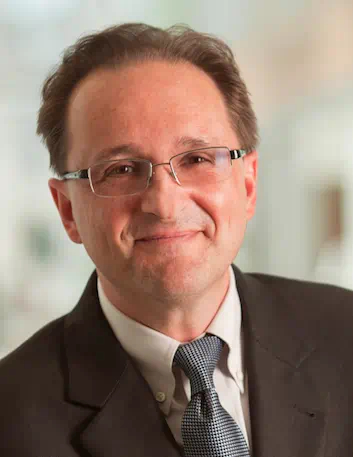A Living Legacy
October 30, 2017
Pioneering UH Seidman Stem Cell Transplant Program embarks on its next 40 years
The University Hospitals Stem Cell Transplant Program recently celebrated its 40th anniversary, featuring appearances by leukemia survivor Mark Rezzano Director, Hematologic Malignancies and Stem Cell Transplant Program, UH Seidman Cancer Center; Professor of Medicine, Case Western Reserve University School of Medicine and oncologist Roger Herzig, MD, who performed Rezzano’s transplant – the first at UH -- back in 1977.
 MARCOS DE LIMA, MD
MARCOS DE LIMA, MDWhat’s on the docket for the next 40 years?
Marcos de Lima, MD, Director, Hematologic Malignancies and Stem Cell Transplant Program, UH Seidman Cancer Center; Professor of Medicine, Case Western Reserve University School of Medicine, points to the potential of chimeric antigen receptor T (CAR T) cell therapies – coming to UH by the middle of 2018.
“This is a revolution,” he says. “These lymphocytes are forced to express a receptor to recognize a given structure in the cancer cell called CD19. They are engineered in a way that they can only do that thing. The cells are given back to the patient, with a huge potential to cure leukemias and lymphomas. It’s pretty neat.”
“We are going to manufacture these cells here in our Cellular Therapy Laboratory in collaboration with outside companies that are going to manufacture the virus ‘vector’ we use to hijack the genetic machinery of the cells,” he says. “This project is relatively close to coming to fruition – by middle of next year, clinical trial should be open for patients with high-risk lymphomas. More generally, CAR T cells may not only extend options of therapy, but also make it possible to treat people who you probably wouldn’t have previously. For now, it has only been realized using the CD19 target, so it’s not a widespread application yet. But the potential is huge.”
Another key priority for Dr. de Lima and the Stem Cell Transplant Program is continuing what he calls “obsessive attention” to quality control.
“For autologous transplants, in January we will complete three years with zero treatment-related mortality,” Dr. de Lima says. “For matched related donor allogeneic transplants, we’ve had those results for more than three years. I think it’s in part the whole system that we have in place for quality control. That goes from the cell products themselves to how we handle central venous access and infection control protocols. It’s the ultimate team sport – it’s hard to pick one thing. For example, we changed the type of catheters that we used, which has reduced the likelihood of catheter infections, which are always a risk. We have standardized our chemotherapy and how we prevent infections. We have also dramatically decreased the variability of care among providers, which has had a significant effect on length of stay. At the end of the day, it’s quality control and standardization of procedures. That has had a major impact.”
Another factor behind this success is the shifting of some stem cell operations to an outpatient setting, Dr. de Lima says. In fact, a new Ambulatory Stem Cell Transplant Unit will soon be opening on the second floor of UH Seidman Cancer Center, adjacent to Radiology. The unit will provide centralized outpatient care to stem cell transplant donors and recipients, with stem cell collections, donor evaluations, photopheresis, post-transplant supportive therapies, bone marrow biopsies and aspirations and outpatient transplant regimens.
“There are several advantages to this,” Dr. de Lima says. “There’s less risk of infection and the psychological boost. Plus, the hospital environment restricts the ability to exercise. We hope with a hybrid approach we can minimize the time spent inpatient. The major target is the multiple myeloma patients and some of the low-intensity allogeneic transplants.”
Such innovations are business as usual for the Stem Cell Transplant Program at UH.
“Hillard Lazarus, MD, who just recently retired and led the program for most of its existence, did a lot of pioneering things,” Dr. de Lima says. “He was important in the development of a medication for AML called Ara-C. He was a pioneer in how we do autologous transplants for multiple myeloma using melphalan. And he was instrumental in developing ways to use mesenchymal stromal cells to help transplant engraftment and decrease graft vs. host disease.”
For more information about the Stem Cell Transplant Program at UH Seidman Cancer Center or to refer a patient, please email Cancer.Innovations@UHhospitals.org.


